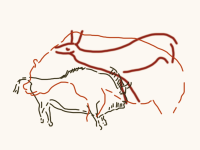
Illustration: Anna Sanchis
The term Xylolithic is completely new. I am sure about it, because I just made it up. It means “made of wood and stone” (from Greek ξυλον [xýlon], “wood”, and λίθος [litos], “stone”). This is how, in my opinion, we should have called the Neolithic, which means “new stone”, as opposed to the Paleolithic, which means “old stone”. Indeed, the Palaeolithic should have been called Lithic, all things considered, and the Neolithic, in the light of what we now know, should have been called Xylolithic.
Climate change is causing a drastic disappearance of glaciers, this much is clear. The melting of permanent ice exposes organic elements that were trapped millennia ago and now emerge intact. They are a sort of frozen fossil. This is the case of the man of Ötzi, a mummified man found in South Tyrol. The ice has allowed the preservation not only of the corpse but also of his clothing, made of skins sewn with vegetable fibres. In this unexpected way, we are now recovering putrescible organic elements that were not available to archaeologists until now.
The man of Ötzi is just over 5,000 years old. Archaeological discoveries of Neolithic organic elements similar to those found in the man of Ötzi are scarce and fragmentary. That is why the remains found in the village of La Draga, on the shores of the Lake of Banyoles, are so valuable. Archaeology makes progress thanks to interpretative rigour and luck. Napoleon said so about his generals: victorious strategists triumph because they also have good luck. It was a stroke of luck to accidentally find the man of Ötzi in 1991, and luck also allowed the discovery, a year earlier, of the Neolithic village of La Draga. It belongs to a human settlement which is over 7,000 years old. Flood anoxia has allowed for the perfect preservation of many organic elements: cereals (mainly bare grain wheat, tetraploid, different from modern hexaploid wheat), hundreds of oak pillars, boxwood, pine, and elderberry utensils, yew bows, oak tools, and even a bow rope made of nettle fibres, as well as numerous bone or horn elements and fragments of cardium ceramics (i.e., decorated with incisions made with Cerastoderma or Cardium shells). The settlement of La Draga shows what we already suspected: the Neolithic revolution, with the invention of agriculture, sedentarisation, and the consolidation of trade routes, led to the generalisation of ceramics and utensils made with organic materials, especially vegetables (wood, fibres, etc.). Stone was still present, but its role was secondary. What is the point of calling this period presided over by wood and with hardly any stone Neolithic?
«What is the point of calling this period presided over by wood and with hardly any stone Neolithic?»
The term gained traction on the proposal of the British historian John Lubbock in his book Prehistoric Times, published in London in 1865; he also introduced the word Paleolithic. These terms were full of meaning, since the vast majority of prehistoric remains found until then were stone utensils. But today we know that the actual Stone Age was the Palaeolithic, that is, the simply Lithic period. Then, the Age of Metals came. And, in between, the Age of Wood, Stone, and Ceramics, that is, the Xiloceralithic or simply Xilolithic…
Words are concept labels. Sentences string words together to express universes of related concepts. That is why it is so important to always use the right term to evoke the concept clearly and accurately. This is not the case with Neolithic. In order to think with acuity, it is convenient to speak with precision, because we think by speaking silently inwards. But language is elaborated from available knowledge, which is usually imperfect. This limitation hinders our cognitive narrative. It is our burden to bear. Such bad luck…
To the memory of Jorge Wagensberg.





